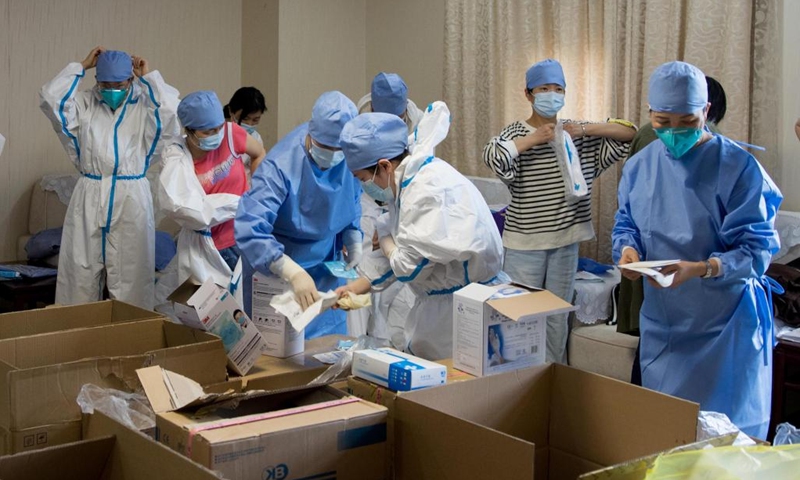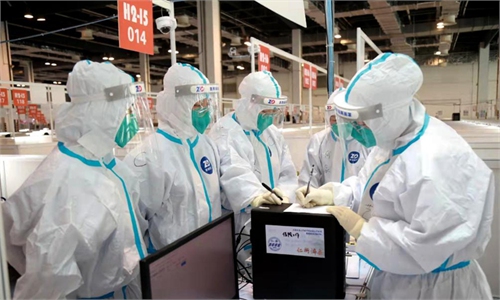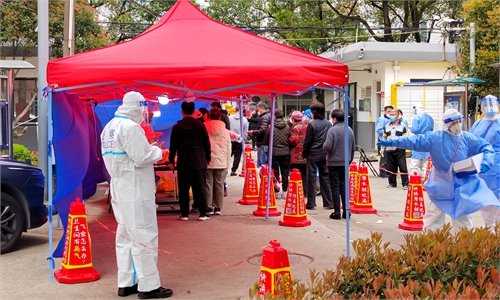Shanghai sees highest daily increase in asymptomatic cases amid calls for home quarantine

Medical workers prepare to carry out nucleic acid tests at a university in Qingpu District of east China's Shanghai, March 14, 2022. Medical workers from the Xianghuaqiao community medical service center in Qingpu District of Shanghai joined the battle against the recent COVID-19 resurgence. They have collected more than 56,000 samples for nucleic acid testing since the latest resurgence in March. (Photo: Xinhua)
Shanghai registered its highest daily tally of asymptomatic cases on Friday as the city faces a tough fight against the Omicron variant. Some experts have called for an exploration of home quarantine to free up more medical resources and ease the pressure from increasing COVID-19 cases.
China on Friday reported 3,489 asymptomatic cases in the Chinese mainland, including 1,582 in Shanghai and 900 in Northeast China's Jilin Province, according to the National Health Commission.
Shanghai has been working on its dynamic zero-COVID strategy to combat Omicron since March, with precise and targeted measures including closed-loop management in certain communities and medical institutions to curb the virus in a precise manner.
At least 41 medical institutes in Shanghai have been suspending certain services due to COVID-19, according to the local authorities on Friday. However, there have been voices claiming that the frequent restrictions in hospitals have caused inconvenience for non-COVID patients.
A Shanghai nurse died of asthma on Wednesday night after treatment was delayed, increasing the spotlight on treatment of non-COVID conditions. The Shanghai local authorities on Friday urged medical institutions to meet residents' needs for first aid.
A more flexible and balanced approach in fighting against Omicron is being explored in the face of the rising COVID-19 numbers. The virus is constantly mutating, and Omicron BA.2's transmissibility is now three to five times that of earlier variants, which means a single case can infect 1,000 people within 10 days, said Zhang Wenhong, head of the Center for Infectious Diseases with the Shanghai-based Huashan Hospital of Fudan University, at Friday's press briefing held in Shanghai.
Under the current strategies including rolling-type screening, the exponential growth of new cases has been contained, Zhang said. Without these measures, positive cases would have increased to at least 10,000 within half a month due to Omicron BA.2's high transmissibility, according to Zhang.
The rising cases have caused pressure in the whole medical system and there are concerns about whether medical resources have been squeezed, Zhang said.
If the proportion of COVID-19 cases in the non-closed-loop regions goes down continuously, the turning point of this outbreak will come soon, Zhang said. But he admitted that it could take a long time to fully contain the virus.
Residents in Shanghai who don't have nucleic test records since March 16 will have their health code turned to yellow, local authorities said on Friday.
The current dynamic zero-COVID policy in Shanghai is still appropriate despite the surging cases, but we must consider the cost, Tao Lina, a Shanghai-based expert on viruses and infectious diseases, told the Global Times on Friday.
Tao said it might be worth considering a policy shift toward home quarantine for asymptomatic carriers, with a monitoring system at the door and supplies being ordered by mobile phone.
It would certainly cut costs, Tao said, adding that nucleic acid tests and immediate home isolation after testing positive would cut off the route of transmission.
Tao said Shanghai will show how well the majority of vaccinated people in the city are coping with COVID-19. The evidence from Hong Kong suggests that vaccination protects effectively against severe illness and death.
The official data shows that over 22 million residents in Shanghai have completed the whole process of COVID-19 vaccination.
"The high proportion of asymptomatic and mild patients in Shanghai is due to the protection of the vaccine and the low pathogenicity of Omicron. In addition, the rounds of nucleic acid testing and screening in key areas enabled the early detection of infected but asymptomatic persons," a Beijing-based epidemiologist told the Global Times on condition of anonymity.
From March 1 to Thursday, over 56,000 local COVID-19 cases have been reported, covering 28 provincial-level regions. Meanwhile, the epidemic situation in Northeast China's Jilin Province is still grim, with the number of newly added cases exceeding 1,000 per day for several days, the national health authorities said on Friday.
In the face of the current epidemic situation in China, the dynamic zero-COVID approach is still the most cost-effective epidemic prevention and control strategy, said Wu Zunyou, chief epidemiologist with the Chinese Center for Disease Control and Prevention, at Friday's press conference held by the State Council.
Only through dynamic zero-COVID can we eliminate the potential risks, avoid a squeeze on medical resources, and prevent the death of a large number of elderly people or those with underlying diseases, according to Wu.
The country's ninth version of the COVID-19 playbook says that mild COVID-19 cases shall be put under centralized quarantine instead of being hospitalized, a move to free up more medical resources, Wang Guiqiang, an expert from Peking University First Hospital, said at Friday's press conference. Asymptomatic cases will also be put under centralized quarantine in community-based facilities instead of hospitals, Wang noted.



